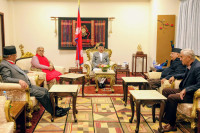Opinion
Chasing the Churia
The sensitive Churia range is under grave threat due to unrestrained mining of stone, sand, and gravel.
Dipendra Gautam
The overexploitation of natural resources has induced severe environmental, hydro-geological, and livelihood problems in the Churia hills and the Tarai. Given the number of frequent landslides, balding terrain, flash floods, slope failures, and biodiversity loss, the unrestricted and haphazard encroachment of stone, gravel, and sand needs a rethink.
Overly exploited
Running east to west, Churia is constituted by 33 districts and segregated from the inner Tarai in the south and Mahabharat in the north. Churia covers about 33 percentage of total land and is characterised by soft unconsolidated rocks that are relatively young. Such rocks are the governing factors for the fragility of geological setups. As this range was covered by dense forest with few public interventions and agricultural expansions before 1990, resource depletion and disasters were infrequent. After the restoration of democracy, population concentration in the Tarai region and expansion towards the ‘charkose jhadi’ became crucial threats to the Churia region.
Recently, fresh debates have started regarding the prioritisation of local peoples to local resources, as per the ILO 169 convention. However, settlements in the Churia range must be identified before assuring such rights, as it is clear that most people there are recent settlers. The next challenge is the encroachment of resources by neighbours, mostly from the inner Tarai. Timber, sand, and gravel smuggling at night have become more frequent after the end to the conflict. Most mines nowadays are exploiting resources out of the periphery allocated to them. In addition, as Churia is the recharge hub for annual precipitation and has thick forest cover, infiltration is promoted rather than surface runoff, preventing flooding and assuring groundwater for communities downstream.
Though sand and gravel mining are revenue sources for the state and the backbone of infrastructure development at the national level, present encroachment has overrun revenue generation in terms of severe environmental, livelihoods, and hydro-geological costs. Every District Development Committee has the right to approve of mining areas; however, due to poor monitoring and inefficient planning the Tarai, Churia, and the Lower Himalayas are under severe threat of disasters. Surely, revenue generation has been overshadowed by budgetary allocation for response and relief after major disasters like floods, droughts, and landslides. The failure of monitoring mechanisms is only facilitating the degradation of the Churia.
Judicious use
While accounting for the Churia’s survival, the government needs to account for the communities residing in this region while declaring the entire area a protected zone wherein only identified and mandated mining can be performed. Present-day malicious mining and timber smuggling must be stopped. For this, effective policies and plans must be developed through the President’s Churia Tarai-Madhes Conservation and Development Committee by formulating specific policies for Churia, as this region has been made very fragile by anthropogenic interventions. Integrated actions are urgently needed from the government to protect the entire Churia range as present programmes have not been effective.
Participatory Churia management is the ultimate solution to assure survival as most resources are smuggled by outliers and farming intervention is widespread among locals. The Churia region is a common hub for displaced people and squatters. The encroachment dynamics relies on the livelihoods of such people. Churia should be completely avoided as a region for settlement and people illegally residing there should be resettled elsewhere.
Policies and planning, proper enforcement of law and order, monitoring and handling of resources to effective management would contribute to preserving natural resources and ensuring sustainable use. Churia could face a vicious cycle of disasters and such disasters could ultimately propagate to the rest of Nepal as well. In this regard, Churia should undoubtedly be protected wherein controlled mining can be allowed and anthropogenic interventions avoided. There must be lucid formulation regarding Churia conservation in legal framework and mining should be conducted under optimal utility frameworks only. In order to secure better habitats for flora and fauna across Nepal, maintain ecosystems, and preserve lives and livelihood, the Churia range must be protected.
Gautam is an anthropologist at the Center for Disaster and Climate Change Studies, Kathmandu




 6.12°C Kathmandu
6.12°C Kathmandu











